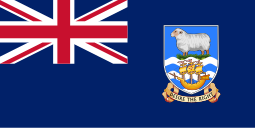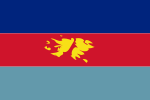
The Red Ensign or "Red Duster" is the civil ensign of the United Kingdom of Great Britain and Northern Ireland. It is one of the British ensigns, and it is used either plain or defaced with either a badge or a charge, mostly in the right half.

The national flag of Anguilla, a British overseas territory, consists of a Blue Ensign with the British flag in the canton, charged with the coat of arms of Anguilla in the fly. The coat of arms consists of three dolphins in a circular formation, which were featured on the earlier Anguillan flag, and which stand for friendship, wisdom and strength. The white in the background stands for peace, and the light blue represents the sea, as well as faith, youth, and hope.

The flag of Belize was adopted on 21 September 1981, the day Belize became independent. It consists of the coat of arms of Belize within a white circle on a blue field with red stripes at the top and bottom.

The flag of Montserrat consists of a Blue Ensign defaced with the British overseas territory's coat of arms. Adopted in 1960 to supplement the Union Jack after the dissolution of the British Leeward Islands the year before, it has been the flag of Montserrat since the territory was granted self-government that year. The design of the present flag entailed enlarging the coat of arms and outlining it with a white trim. Montserrat's flag is similar to the flags of eight other British Overseas Territories, which are also Blue Ensigns with their respective coats of arms.

The flag of Uganda was adopted on 9 October 1962, the date that Uganda became independent from the British Empire. It consists of six equal horizontal bands of black (top), yellow, red, black, yellow, and red (bottom); a white disc is superimposed at the centre and depicts the national symbol, a grey crowned crane, facing the hoist's side.

The flag of the British Virgin Islands was adopted by Royal Warrant on 15 November 1960 after the islands were made into a separate British colony. Previously, the territory was administered as part of the British Leeward Islands.

The flag of the Cayman Islands consists of a Blue Ensign defaced with the British overseas territory's coat of arms. Adopted in 1959 to supplement the Union Jack and to replace the flag of the Colony of Jamaica, it has been the flag of the Cayman Islands since the territory was granted self-government that year. The design of the present flag entailed removing the white disc and outlining the coat of arms with a white trim, although the previous version is often used in an official capacity. The Cayman Islands' flag is similar to the flags of eight other British Overseas Territories, which are also Blue Ensigns with their respective coats of arms.

The flag of The Gambia is the national flag of The Gambia. It consists of three horizontal red, blue and green bands separated by two thin white lines. Adopted in 1965 to replace the British Blue Ensign defaced with the arms of the Gambia Colony and Protectorate, it has been the flag of the Republic of the Gambia since the country gained independence that year. It remained unchanged throughout the Gambia's seven-year confederation with Senegal.

In vexillography, the canton is a rectangular emblem placed at the top left of a flag, usually occupying up to a quarter of a flag's area. The canton of a flag may be a flag in its own right. For instance, British ensigns have the Union Jack as their canton, as do their derivatives such as the national flags of Australia and New Zealand.
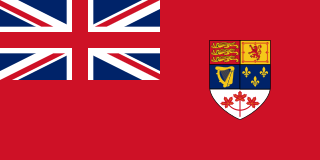
The Canadian Red Ensign served as a nautical flag and civil ensign for Canada from 1892 to 1965, and later as the de facto flag of Canada before 1965. The flag is a British Red Ensign, with the Royal Union Flag in the canton, emblazoned with the shield of the coat of arms of Canada.
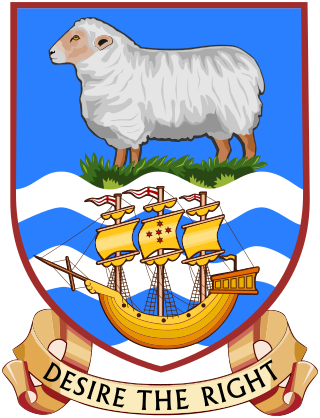
The coat of arms of the Falkland Islands is the heraldic device consisting of a shield charged with a ram on tussock grass in a blue field at the top and a sailing ship on white and blue wavy lines underneath. Adopted in 1948, it has been the coat of arms of the Falkland Islands since 29 September of that year, except for the two-month occupation of the territory during the Falklands War in 1982. The escutcheon is featured on the flag of the territory. The ram represents the territory's past primary industry of sheep farming, while the ship symbolises the Desire which reportedly first sighted the islands at the end of the 16th century. The grass indicates the vegetation of the Falklands.

The flag of the British Antarctic Territory was granted on 21 April 1998. It features the coat of arms granted on 1 August 1963, a year after the British Antarctic Territory, a British Overseas Territory, was created. Previously, the Territory was a part of the Falkland Islands Dependencies and used the same flag. On 30 May 1969, a blue ensign with the British Antarctic Territory coat of arms in the fly was introduced as a government ensign.
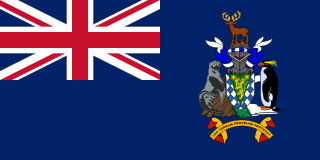
The flag of South Georgia and the South Sandwich Islands was granted on 3 October 1985, when the Territory was created. Previously the Territory was a part of the former Falkland Islands Dependencies and used the same flag as the Falklands Islands.

The coat of arms of Tristan da Cunha was granted on 20 October 2002.

The coat of arms of South Georgia and the South Sandwich Islands was granted in 1985, upon the creation of the territory. Prior to 1985, South Georgia and the South Sandwich Islands were a dependency of the Falkland Islands, and used their coat of arms. However, prior to 1962, the islands were grouped with what is now the British Antarctic Territory and their coat of arms was used instead of the Falkland Islands’ arms.
The island nation of Malta has a variety of national flags and symbols, some current and some no longer in use.

The Star of India refers to a group of flags used during the period of the British Raj in the Indian subcontinent. India had a range of flags for different purposes during its existence. The Princely states had their own flags which were to be flown alongside the British flag as a symbol of suzerainty. The official state flag for use on land was the Union Flag of the United Kingdom and it was this flag that was lowered on Independence Day in 1947. The flag of the governor-general of India was defaced with the Star of India. The civil ensign and naval ensign were the Red Ensign or Blue Ensign, respectively, defaced with the Star of India emblem.

The current flag of the Turks and Caicos Islands was adopted on 7 November 1968, and modified in 1999. Prior to this, the islands had several different flags either proposed or utilised.
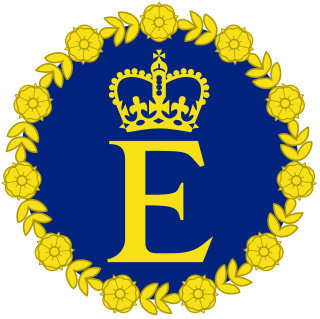
Queen Elizabeth II had a variety of flags to represent her personally and as head of state of several independent nations around the world. They were usually used on any building, ship, car, or aircraft where she was present.
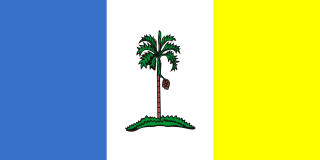
The flag of Penang consists of three vertical bands and an areca-nut palm on a grassy mount in the centre. All three bands are of equal width. From left to right, the colour of each band is light blue, white and yellow.
